 Since 1996, this collaborative project has grown to include 4,418 articles by 25 contributors, including researchers, collectors, artists and historians covering topics from Art Nouveau to Zoology. We move beyond simply cataloguing playing cards by date, manufacturer and place of origin, and adopt a dynamic, interactive and thematic approach, bridging the past with the present, telling stories, opening conceptual perspectives and the necessary reflectiveness to gain new insights and ways to appreciate their role in history.
Since 1996, this collaborative project has grown to include 4,418 articles by 25 contributors, including researchers, collectors, artists and historians covering topics from Art Nouveau to Zoology. We move beyond simply cataloguing playing cards by date, manufacturer and place of origin, and adopt a dynamic, interactive and thematic approach, bridging the past with the present, telling stories, opening conceptual perspectives and the necessary reflectiveness to gain new insights and ways to appreciate their role in history.
New Articles
Start DiscussionCurrent Highlights
Perspectives on the History of Tarot
Tarot, originally a 15th century card game from Italy, has evolved into a form of personal mysticism...
Cartes Lenormand
“Cartes Lenormand” published by H. P. Gibson & Sons Ltd, London, printed in Germany by B. Dondorf, 1...
Victorian playing cards
54 different card designs including people, animals, flowers, costumes and ornaments popular during ...

History of Court Cards
The court cards in English packs of playing cards derive from models produced by Pierre Marechal in ...
Early History of Playing Cards & Timeline
Out of an apparent void, a constellation of references in early literature emerge pointing to the su...

14: Back Designs
A few examples of the many interesting back designs.

The History of Playing Cards
Playing Cards have been around in Europe since the 1370s. Some early packs were hand painted works o...
Dungeons and Dragons Tarot
This 78-card officially licensed Dungeons & Dragons (D&D) tarot deck offers a visually appealing var...

Rider Waite Tarot early editions
Rider Waite Tarot early editions
Explore
4,420 articles featuring content from 118 countries, 1,294 manufacturers and 1,069 designers; including 385 themes, 265 brands, 76 suits, 48 games and 29 licenses.

The playing card calls for artistic treatment and although the constrained size imposes some limitations there is an almost bewildering wealth and variety of designs in playing cards and their tuck boxes. The serious player requires design to be unobtrusive so that aesthetic considerations remain in the background. However, with modern manufacturing technology more eye-catching designs are becoming popular as gifts, collectibles and for their attractive appearance. more ►

14: Back Designs
By Ken Lodge

Le Jeu de Marseille
By Barney Townshend

Modern Aces of Spades
By Matt Probert

Owen Jones (1809-1874)
By Simon Wintle

Political playing cards were introduced in the 17th century providing entertainment by satirising or deriding current events and leaders. Propaganda cards, Imperial decks, war cards and even educational card games all carry a message which relates to the politics of memory, the means by which events are remembered and recorded, the way history is written and passed on. Historical memory can be used to arouse emotional reactions...

Trump Presidential playing cards
By Peter Burnett

Anti-Religions
By Barney Townshend

House of Commons Playing Cards
By Peter Burnett

Knavery of the Rump, 1679
By Simon Wintle

The 'Joker' is believed to have been invented by American Euchre players who, when modifying the rules sometime during the 1860s, decided that an extra trump card was required. more ►

Why our playing-cards look the way they do
By Paul Bostock

De la Rue’s 125th anniversary
By Simon Wintle

Baggy Clown Joker
By Rex Pitts (1940-2021)

Malaysia Airlines
By Matt Probert

The famous Bicycle playing cards were first introduced by Russell & Morgan Printing Co in 1885. More recently the brand has been open to private designers since the early 2000s. more ►

Russell, Morgan & Co
By Rod Starling (1936-2023)

Hesslers Four-Colour “No Revoke” Deck
By Simon Wintle

Different Playing Cards by Teach By Magic
By Adam Wintle

Hesslers Enhanced
By Simon Wintle

In 1889, Fusajirô Yamauchi began manufacturing “Hanafuda” or “flower cards” under the brand name Nintendo Koppai. Cards were hand crafted using the bark from mulberry and mitsu-mata trees. Around 1902 the firm began producing Western style playing cards.

Japanese Playing Cards
By Simon Wintle

Hanafuda Flower Cards
By Simon Wintle

Ainu culture
By Rex Pitts (1940-2021)

Ukiyo-E (Nintendo)
By Roddy Somerville
The Big Picture
Playing cards have a universal appeal and are a reflection of human culture.
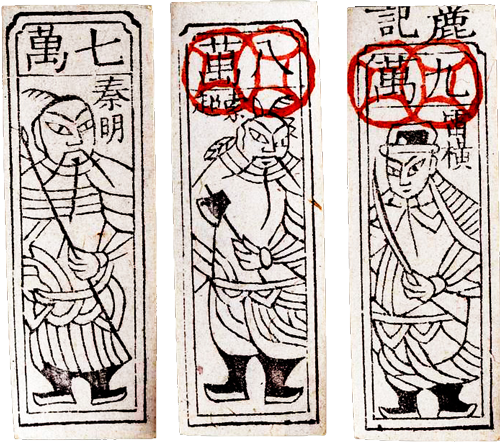
Above: Chinese money-suited cards. Some of the earliest cards have origins in the Far East.
Playing cards are a part of almost every culture and society around the world. These small, rectangular pieces of paper have been a source of entertainment for generations and are still enjoyed by people of all ages today. Whether it's a simple game of solitaire, a high-stakes game of poker, or a magic trick that delights, there's something about playing cards that captures the imagination and inspires creativity. As Delef Hoffmann once said "whether we consider cards as mere merchandise or as the bond which unites people with one another, just think of what we would be if we had no cards! How boring and unsociable our lives would be without this invention!"
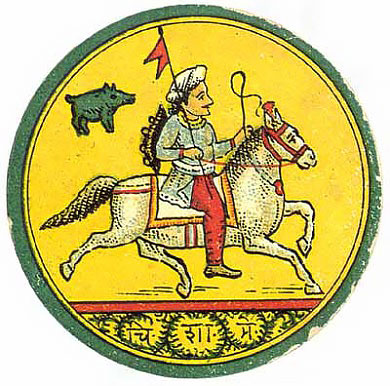
Above: Dasavatara Ganjifa from India. Playing cards from India are often circular.
The origin of cards can be traced back to China, where they were first used as early as the 9th century. From there, the cards travelled across Asia and the Middle East, and finally found their way to Europe in the 14th century.
Since then, playing cards have been used for a wide range of purposes, including fortune-telling and even propaganda. But the most significant impact they have had on humanity is through their use in games, which have brought people together for centuries.
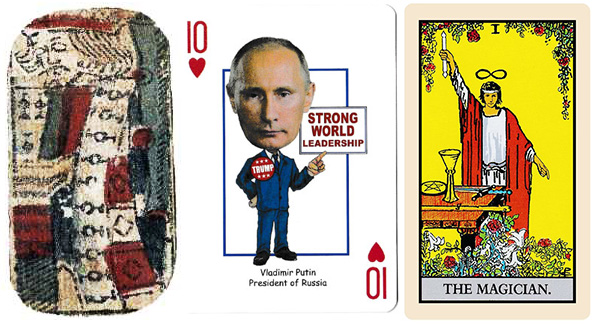
Above left: a set of Spanish playing cards from 1638 was discovered inside a prison wall during demolition, likely used for gambling by prisoners. Above center: Trump Presidential playing cards, playing cards are often used for political messages. Above right: the Magician from the popualr Rider-Waite tarot, which has become the template for modern tarot decks.
While playing cards have brought people together for fun and play, they have also been a source of disruption in the form of gambling. For many, gambling has become an addiction, leading to financial ruin and even anti-social problems.
The artistic value of cards cannot be overlooked, with their intricate details and unique designs of each card reflecting the creativity and ingenuity of artists. Playing cards are a reflection of our society, with each country and region having its unique designs and styles. As Sylvia Mann put it "there are fashions in cards, and these fashions very often reflect the history of the times". From the bold and colourful designs of India to the intricate and detailed patterns of Russia, playing cards are a testament to the creativity and diversity of the human experience.
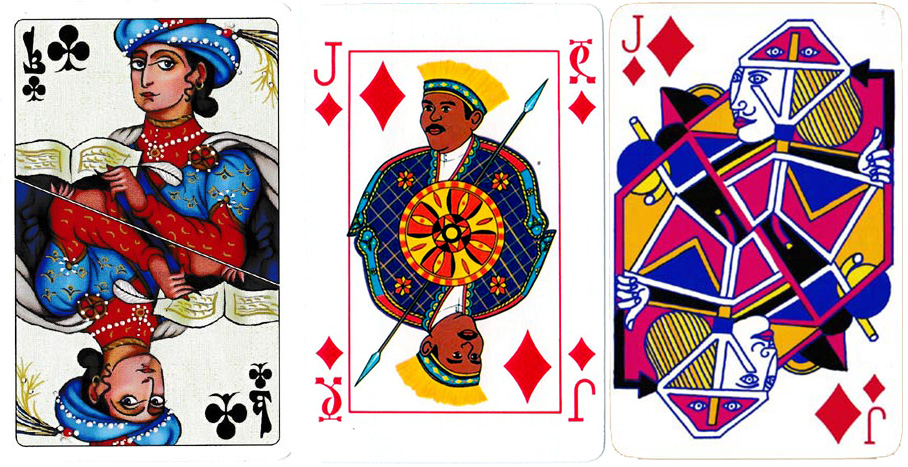
Above left: Kashmir Playing Cards, above center: Ethiopian Air Lines playing cards produced by Nintendo, above right: striking playing cards designed by Masuo Ikeda.
Playing cards have a wide embrace, spanning across cultures and countries, with a scope of diverse subjects that reflect the values and beliefs of their respective societies.
Playing cards are an enduring symbol of human connection and creativity, transcending language, borders and cultures. Through the power of games, they have brought people together for centuries, creating shared experiences that have fostered friendships, learning and social bonds. While their role in gambling has been disruptive, their stunning artistic designs elevate them to works of art, worthy of appreciation and admiration. Playing cards are a testament to the power of human creativity and a reflection of the rich cultural tapestry of our world.
References
- The Playing Card, Delef Hoffmann, 1972
- Collecting Playing Cards, Sylvia Mann, 1966
About the World of Playing Cards
Our aim is to increase awareness and appreciation of the cultural and historical significance of playing cards.
The World of Playing Cards was established in 1996 as a place where you can learn about playing cards, their history, design and manufacture, and see cards from around the world.

Simon Wintle (right) with Adam Wintle (left) visiting Ayutthaya in Thailand, 2016.
They reflect the traditions of many countries. They vary widely in size, style, shape, artistry, usage and many other purposes in education, marketing or even for fortune telling. There is a fascination in playing card design: the neat symmetries and quirky symbols. The composition of the pack - court cards, suits, pips - provides endless scope of play.
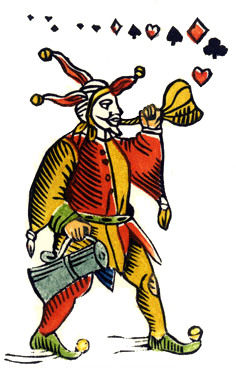
They are recognised everywhere around the world - we rarely question their origins.
Since their invention, cards have lost none of their popularity. Playing cards have a long history and it's in the art that the richness of playing cards is to be discovered.
Simon & Adam





























